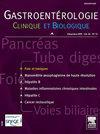健康受试者和经博氏酵母治疗的腹泻患者结肠微生物群(中央发酵区、生发区和分离黏液层)的功能生物结构
摘要
结肠内容物可以比作一个空间结构的高产生物反应器,由三个功能不同的区域组成:分离黏液层、生发存量区和中央发酵区。粪便反映了这种结构,可以用于健康和疾病的诊断。在第一部分中,我们介绍了一种基于荧光原位杂交(FISH)的新方法,该方法可以定量监测粘液,生发原液和中央发酵区的微生物群。在第二部分中,我们演示了这种方法的实际实施,描述了健康受试者和用博氏酵母治疗的慢性特发性腹泻患者的粪便微生物群的生物结构。采用荧光原位杂交技术对20例慢性特发性腹泻患者和20例健康对照者的穿孔粪便柱进行了研究。评估了73个细菌群。在口服博氏酵母菌前3周、补充期间3周和补充后3周,每周监测11个组成菌群的组装波动。健康受试者典型表现为5 ~ 60 μm粘液分离层;Bacteroides、Roseburia和Faecalibacterium prausnitzii三个习惯菌群分布均匀且荧光,浓度高(>10 × 1010个/mL);偶尔也有低浓度的细菌群。腹泻可以描述为增加分离努力,净化,去污,细菌替代。腹泻的典型表现为:保护性黏液层厚度增加,与粪便合并,习惯性细菌群浓度绝对降低,中央发酵区细菌代谢受到抑制(杂交沉默),粪便结构被水样成分分层,偶尔细菌群浓度代谢性增加。通过博氏酵母菌治疗,腹泻的微生物和临床症状是可逆的。粪便微生物群的结构-功能分析可以定量监测结肠功能障碍及其对治疗的反应。博氏酵母菌能显著改善慢性特发性腹泻患者的粪便生物结构,对健康人的粪便微生物群无影响。Le contu du côlon peut être compare.com unbioracacteur haut danci.com/ danci.com/结构空间上重要的三个danci.com/功能不同的danci.com/:一个couche de,一个zone germinale de,一个zone centrale de。Les selles反射性结构和防止être应用程序在诊断之前无法使用,否则将无法使用。首先,我们介绍了一种原位荧光杂交法(FISH),一种原位荧光杂交法(FISH),一种原位荧光杂交法(FISH),一种原位荧光杂交法(FISH),一种原位荧光杂交法(FISH),一种原位荧光杂交法(FISH),一种原位荧光杂交法(FISH),一种原位荧光杂交法(FISH),一种原位荧光杂交法(FISH),一种原位荧光杂交法(FISH),一种原位荧光杂交法(FISH),一种原位荧光杂交法(FISH),一种原位荧光杂交法(FISH)。在第二当事人中,有一种情况是:<s:1> <s:1> <s:1> <s:1> <s:1> <s:1> <s:1> <s:1> <s:1> <s:1>,即<s:1> <s:1> <s:1> <s:1> <s:1> <s:1>·······················20例患者患有慢性特发性腹泻病,20例患者患有慢性特发性腹泻病,20例患者患有先天性腹泻病,20例患者患有先天性腹泻病,20例患者患有先天性腹泻病,20例患者患有先天性腹泻病。Soixante-treize组分为两个组,分别是:<s:2> <s:2>;11组的波动和组合- - - - - - - - - - - - - - - - - - - - - - - - - - - - - - - - - - - - - - - - - - - - - - - - - - - - - - - - - - - - - - - - - - - - - - - - - - - - - - - - - - - - - - - - - - - - -在5-60 μm范围内,有3种典型的大肠杆菌和1种典型的大肠杆菌;在5-60 μm范围内,有1种分布和1种荧光均匀性;在10 × 1010个大肠杆菌/mL范围内,有3种典型的大肠杆菌和3种常见的大肠杆菌,如拟杆菌、玫瑰杆菌和prausnitzii粪杆菌,有3种典型的大肠杆菌。La diarrhee pu可能decrite en术语d 'augmentation de l 'effort de分离、净化的d 'epuration,不吸烟者替换bacterienne。1 .不饱和、不饱和、不饱和、不饱和、不饱和、不饱和、不饱和、不饱和、不饱和、不饱和、不饱和、不饱和、不饱和。一种分层的结构结构,其主要组成部分和一种增强型补偿,其主要组成部分的浓度。symptômes微生物与腹泻病的临床研究:与博氏酵母菌的鉴定。The colonic content can be compared to a spatially structured high output bioreactor composed of three functionally different regions: a separating mucus layer, a germinal stock area, and a central fermenting area. The stool mirrors this structure and can be used for diagnosis in health and disease. In a first part, we introduce a novel method based on fluorescence in situ hybridization (FISH) of sections of punchedout stool cylinders, which allows quantitatively monitor microbiota in the mucus, the germinal stock and the central fermenting areas. in a second part, we demonstrate the practical implementation of this method, describing the biostructure of stool microbiota in healthy subjects and patients with chronic idiopathic diarrhea treated with Saccharomyces boulardii. Punched stool cylinders from 20 patients with chronic idiopathic diarrhea and 20 healthy controls were investigated using fluorescence in situ hybridization. Seventy-three bacterial groups were evaluated. Fluctuations in assembly of 11 constitutive bacterial groups were monitored weekly for 3 weeks prior to, 3 weeks during, and 3 weeks after oral Saccharomyces boulardii supplementation. Typical findings in healthy subjects were a 5-60 μm mucus separating layer; homogeneous distribution and fluorescence, high concentrations (>10 × 1010 bacterial/mL) of the three habitual bacterial groups: Bacteroides, Roseburia and Faecalibacterium prausnitzii; and low concentrations of the occasional bacterial groups. The diarrhea could be described in terms of increased separating effort, purging, decontamination, bacterial substitution. Typical findings in diarrhea were: increased thickness of the protective mucus layer, its incorporation in the stool, absolute reduction in concentrations of the habitual bacterial groups, suppression of bacterial metabolism in the central fermenting area (hybridization silence), stratification of the stool structure by watery ingredients, and substitutive increase in the concentrations of occasional bacterial groups. The microbial and clinical symptoms of diarrhea were reversible with Saccharomyces boulardii therapy. The structure-functional analysis of stool microbiota allows to quantitatively monitor colonic malfunction and its response to therapy. Saccharomyces boulardii significantly improves the stool biostructure in patients with chronic idiopathic diarrhea and has no influence on the stool microbiota in healthy subjects.
Le contenu du côlon peut être comparé à un bioréacteur à haut débit doté d’une structure spatiale comportant trois régions fonctionnellement différentes : une couche de mucus séparatrice, une zone germinale de réserve et une zone centrale de fermentation. Les selles reflètent cette structure et peuvent être utilisées comme un outil diagnostique chez le sujet sain ou malade. Dans la première partie, nous introduisons une méthode innovante fondée sur l’étude par hybridation fluorescente in situ (FISH) de coupes de selles prélevées par carottage, ce qui permet une évaluation quantitative du microbiote dans le mucus, dans la zone de réserve germinale et dans la zone centrale de fermentation. Dans une seconde partie, nous démontrons la mise en œuvre pratique de cette méthode en décrivant la biostructure du microbiote fécal chez des sujets sains et chez des patients atteints de diarrhée chronique idiopathique traités par Saccharomyces boulardii. Des carottes de selles de 20 patients souffrant de diarrhée chronique idiopathique et de 20 témoins sains ont été étudiées par la méthode de FISH. Soixante-treize groupes bactériens ont été évalués. Les fluctuations dans la combinaison de 11 groupes bactériens constitutifs ont été observées chaque semaine pendant trois semaines avant, trois semaines pendant et trois semaines après une supplémentation orale par Saccharomyces boulardii. Les constatations typiques des sujets sains étaient une couche muqueuse séparatrice de 5-60 μm, une distribution et une fluorescence homogènes, de fortes concentrations (>10 × 1010 bactéries/mL) des trois groupes bactériens habituels - Bacteroides, Roseburia et Faecalibacterium prausnitzii - et de faibles concentrations des groupes bactériens occasionnels. La diarrhée a pu être décrite en termes d’augmentation de l’effort de séparation, d’épuration, de décontamination et de substitution bactérienne. Les constatations caractéristiques de la diarrhée étaient une augmentation d’épaisseur de la couche muqueuse protectrice, son incorporation aux selles, une réduction absolue des concentrations des groupes bactériens habituels, une inhibition du métabolisme bactérien dans la zone centrale de fermentation (disparition du signal d’hybridation), une stratification de la structure des selles par des ingrédients aqueux et une augmentation compensatoire des concentrations des groupes bactériens occasionnels. Les symptômes microbiens et cliniques de la diarrhée étaient réversibles après le traitement par Saccharomyces boulardii. L’analyse du rapport structure/fonction du microbiote fécal permet de caractériser quantitativement la dysfonction colique et sa réponse au traitement. Saccharomyces boulardii améliore significativement la biostructure des fèces au cours de la diarrhée chronique idiopathique et n’a pas d’effet sur le microbiote fécal des sujets sains.

 求助内容:
求助内容: 应助结果提醒方式:
应助结果提醒方式:


